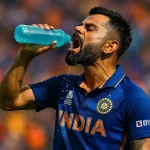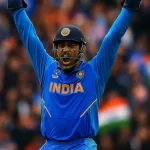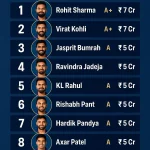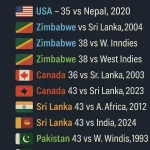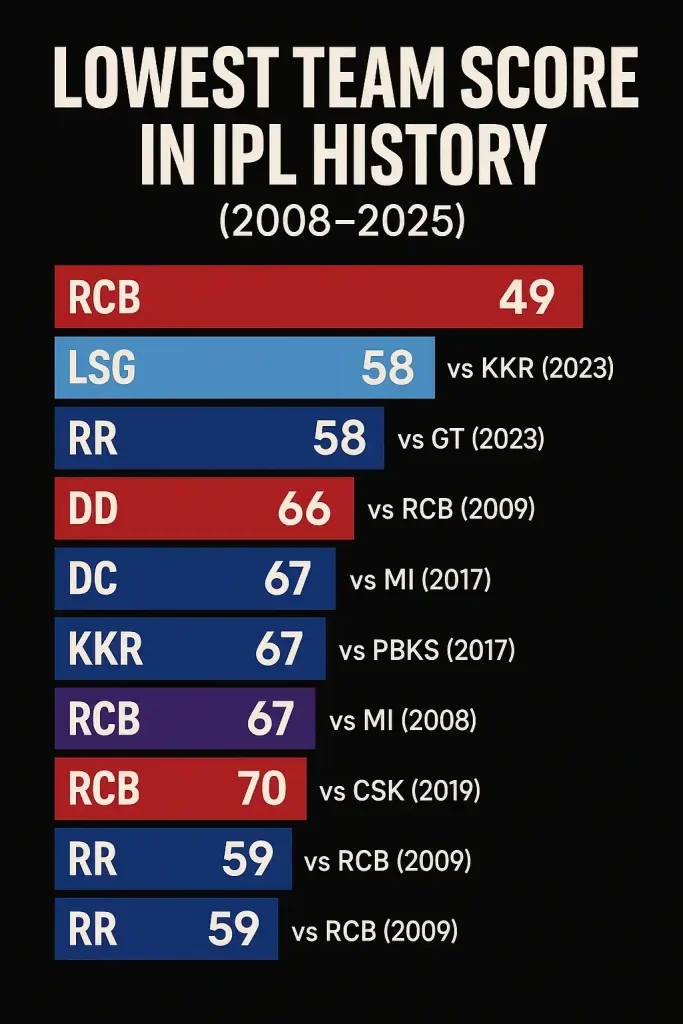
The Indian Premier League is built on a promise — sixes flying, totals climbing, stadiums roaring. But sometimes, the script flips. Instead of 200-plus thrillers, you get scorecards that look broken. Single digits. Duck parades. Panic in the dugout. The top 10 lowest score in IPL history isn’t a list of failures — it’s a gallery of collapses, ambushes, and bowlers who smelled blood.
And let’s be honest: as much as we love power-hitting, there’s a strange thrill in watching wickets tumble. It’s raw. It’s messy. And it reminds us that T20 is still a game of skill, not just muscle.
Let’s walk through the lowest totals ever recorded — and why each one still echoes through IPL folklore.
The Collapse Diaries: The IPL’s Strikingly Sharp Scoring Averages
There is always a story behind the reason why low-scoring games occur. They highlight streaks of pressure, cause for concern, exceptional spells, poor shot selection, or occasionally the odd tempo of the game. T20 matches are not like ODIs or Tests. There is no time to settle into a rhythm. If there is one early collapse, the rest of the team collapses like dominoes.
In these heavily dominated matches, scoring is such an abrupt process that the teams do not get a chance to recover. It is reminiscent of a car that is skidding off the track. At this point, it becomes irreversible.
Whether it is a result of a fierce opening spell or a spicy pitch, these matches are windows into what happens when strategy goes out the window and instinct kicks in.
Top 10 Lowest Score in IPL History (2008–2025)
Here’s the updated list of the lowest team totals ever recorded in IPL history. These aren’t just statistics — every line on this table is a story of stunned fans, disbelieving captains, and bowlers running riot.
| Rank | Team | Score | Overs | Opponent | Year | Venue |
| 1 | Royal Challengers Bangalore | 49 | 9.4 | Kolkata Knight Riders | 2017 | Eden Gardens |
| 2 | Rajasthan Royals | 58 | 15.1 | Royal Challengers Bangalore | 2009 | Cape Town |
| 3 | Delhi Daredevils | 66 | 13.4 | Mumbai Indians | 2017 | Feroz Shah Kotla |
| 4 | Delhi Capitals | 67 | 17.1 | Kings XI Punjab | 2017 | Mohali |
| 5 | Kolkata Knight Riders | 67 | 15.2 | Mumbai Indians | 2008 | Wankhede |
| 6 | Royal Challengers Bangalore | 70 | 17.1 | Chennai Super Kings | 2019 | Chennai |
| 7 | Royal Challengers Bangalore | 70 | 16.1 | Rajasthan Royals | 2014 | Abu Dhabi |
| 8 | Kings XI Punjab | 73 | 15.5 | Rising Pune Supergiant | 2017 | Pune |
| 9 | Kochi Tuskers Kerala | 74 | 16.3 | Deccan Chargers | 2011 | Kochi |
| 10 | Chennai Super Kings | 79 | 15.2 | Mumbai Indians | 2013 | Wankhede |
#1: The 49 All-Out – A Meltdown Etched in Memory
There’s no talking about the top 10 lowest score in IPL history without pausing at the lowest of them all — RCB’s 49 all-out. It didn’t just set a record. It set the tone for what can happen when a batting order implodes.
It was 2017, and the venue was Eden Gardens — a pitch known for being fair. But RCB looked anything but balanced. Chasing just 132 against KKR, a lineup with Gayle, Kohli, and de Villiers collapsed in just 9.4 overs. No one crossed double digits. Not even extras.
What made this special was the speed of the collapse. Four wickets down before the powerplay. Middle-order unsure. Tail blown away. KKR’s bowlers — especially Nathan Coulter-Nile and Chris Woakes — bowled with venom.
It wasn’t just a defeat. It was a dissection.
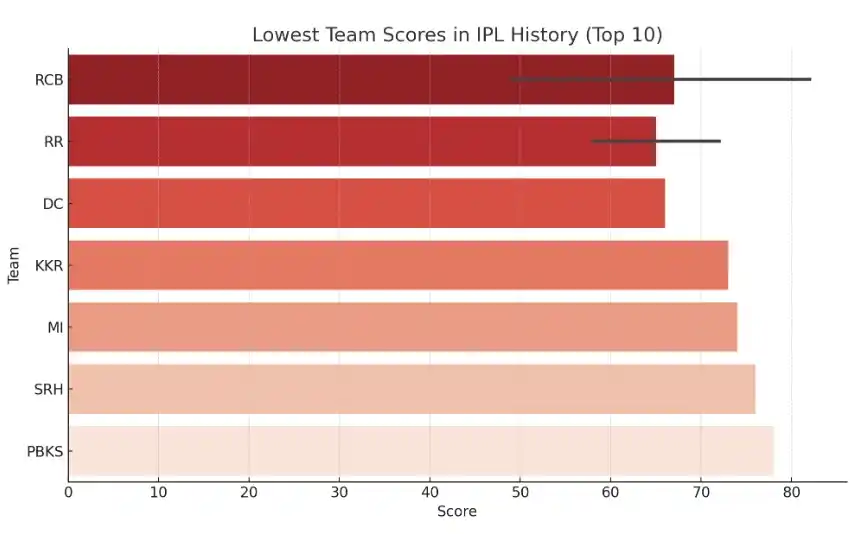
When Royals Crumbled: Rajasthan’s Forgettable 58
Back in 2009, the IPL was in South Africa, and the conditions weren’t as batting-friendly. But that doesn’t explain Rajasthan Royals’ 58 all-out against RCB.
Defending champions at the time, RR looked clueless against Praveen Kumar and Anil Kumble. Batsmen misjudged length, and the bounce caught them by surprise. What should have been a par 140 track turned into a nightmare.
RCB chased it down easily, and Kumble’s smile said it all — class trumps chaos.
Wicket-by-Wicket Breakdown: RCB’s 49 All-Out
Here’s a closer look at how that infamous RCB innings played out — over by over, collapse by collapse.
| Fall of Wicket | Score | Batsman | Bowler |
| 1st | 7 | Mandeep Singh | Umesh Yadav |
| 2nd | 9 | Virat Kohli | Nathan Coulter-Nile |
| 3rd | 11 | AB de Villiers | Coulter-Nile |
| 4th | 21 | Kedar Jadhav | Chris Woakes |
| 5th | 31 | Shane Watson | Woakes |
| 6th | 35 | Stuart Binny | Woakes |
| 7th | 36 | Pawan Negi | Nathan Coulter-Nile |
| 8th | 39 | Samuel Badree | Sunil Narine |
| 9th | 47 | Tymal Mills | Narine |
| 10th | 49 | Yuzvendra Chahal | Colin de Grandhomme |
That’s what you call system failure.
What These Games Teach Us About IPL Pressure
If there’s a pattern to be found across the top 10 lowest scores in IPL history, it’s this — pressure does strange things. Even the best batters lose their sense of timing when wickets fall early. And no T20 innings recovers from a 4/15 scenario. You panic. You push. You perish.
Interestingly, these collapses often come after:
- A slow powerplay start
- Over-dependence on top order
- Lack of clarity in chasing middling targets
- Underestimating spin (especially on dry tracks)
The 2017 season alone gave us three entries on the lowest-score list. That wasn’t a coincidence — it was a period where bowling strategies matured faster than batting line-ups adapted.
Did the IPL Rules Impact Low Scores?
Absolutely. Rule changes around the impact player, fielding restrictions, and DRS availability have all influenced how teams plan innings. But often, collapses happen not because of the rules, but because of mindset. Teams built for 200+ don’t always adapt when a pitch demands 140.
And then there’s the flip side — teams resting players before playoffs, or underestimating struggling squads. That complacency leads to the kind of scoreboard that ends with your dressing room in stunned silence.
Most Common Factors Behind IPL Batting Collapses
| Factor | Frequency (Top 10 Matches) | Notable Example |
| Top-order failure | 10/10 | RCB vs KKR (2017) |
| Seam-friendly conditions | 7/10 | RR vs RCB (2009 in Cape Town) |
| Middle-order inexperience | 6/10 | KXIP vs RPS (2017) |
| Spin choke in middle overs | 4/10 | DC vs MI (2017) |
| Chasing under pressure | 6/10 | CSK vs MI (2013) |
The data doesn’t lie. Winning in T20 is not just about firepower — it’s about temperament.
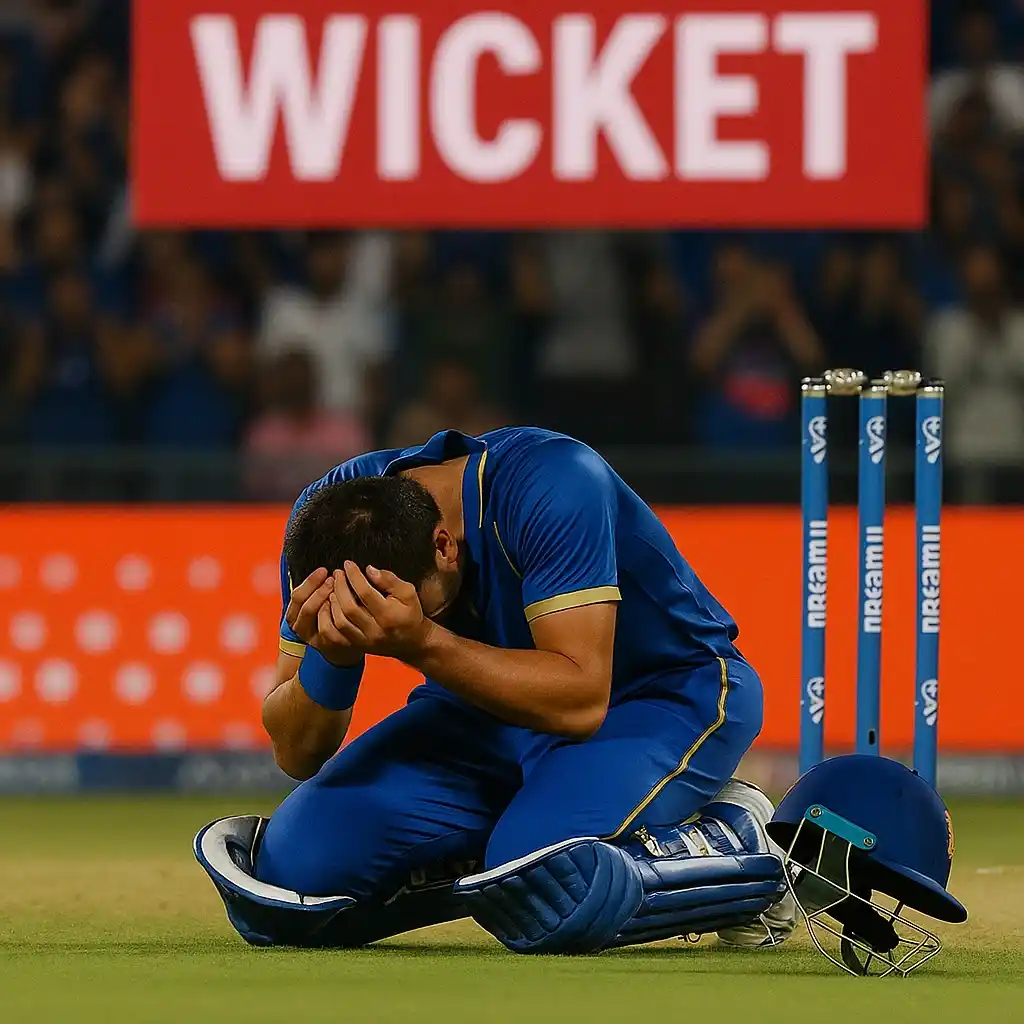
The Rebound: What Happened After These Collapses?
Some teams never recovered that season. Others used it as a wake-up call. RCB’s 49? It lit a fire. Rajasthan’s 58? They restructured their entire batting order. Delhi’s twin collapses in 2017? The birth of a new core featuring Rishabh Pant and Prithvi Shaw.
Sometimes, the worst moments become the turning points. And that’s the emotional backbone of the IPL — drama that leads to reinvention.
Final Word: Technological Transformation in Sports Analytics
Clearly, the IPL features entertainment, 200-run chases, and massive sixes. However, its allure goes beyond the IPL’s unpredictable nature. On any given day, the IPL could witness the worst score in its entire history. And to any follower, those spectacular moments mark the most eventful nights for Twitter, chroniclers, and players to take center stage.
No matter how shabby it might appear, it remains straightforward.

Meet Arjun Kushaan, a passionate cricket analyst at The Cricket24x7. From street matches in his childhood to competitive college tournaments, cricket has always been a central part of Arjun’s life. With a strong background in data analysis and a natural affinity for numbers, he brings a fresh, analytical lens to the game. At The Cricket24x7, Arjun blends his deep love for cricket with his data-driven approach to deliver detailed insights and well-rounded coverage for fans of the sport.

